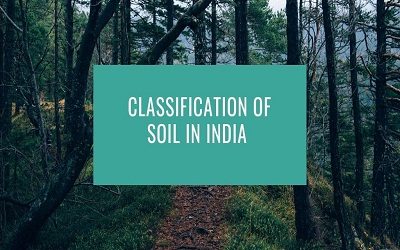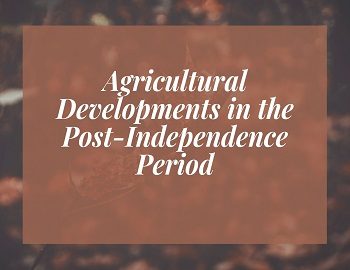Table of Contents
Classification of Soils in India: Important Facts

- Soil is the uppermost layer of the earth’s crust capable of supporting life.
- Soil is the most important renewable natural resource.
- The major factors affecting the formation of soil are relief, parent material, climate, vegetation, and other life-forms and time.
- Besides these, human activities also influence it to a large extent.
Layers of Soil:
The three layers of soil are:
A-Horizon:
- The uppermost layer of the soil is called topsoil or A-horizon.
- It is the darkest of all layers. The dark color is due to the presence of humus which makes the soil fertile.
- This layer contains roots of many plants that absorb water and nutrients from it.
- Soil is soft and porous with greater capacity to hold water.
- The topsoil is home to many organisms like bacteria, algae, fungi, insects, and worms.
B-Horizon:
- The layer of soil below the A-Horizon is called subsoil or B-Horizon.
- The subsoil is harder and more compact than the topsoil.
- It does not contain humus and is, therefore, lighter in color than the topsoil.
- B-Horizon is rich in soluble minerals and iron oxides.
- Roots of certain tall trees may reach up to this layer.
C-Horizon:
- The lowest layer of soil is called the C-Horizon.
- This layer consists of small pieces of the parent rock.
- Weathering of these pieces of rocks results in soil formation.
- The rock pieces contain many cracks and crevices. Although no organic matter (humus) is present in this layer, it contains some minerals.
- Beneath the C-Horizon is present the solid parent rock called the bed-rock.
What is weathering?
The process of breaking down of rocks into smaller pieces by the action of agents of nature like wind, rain, running streams, glaciers, alternately high and low temperatures, and soil organisms is called weathering.
Classification of Soils In India:
- Soil is a natural surface layer of the lithosphere containing living matter and is capable of supporting vegetation.
- In ancient times, soils used to be classified into two main groups- Urvara and Usara, which were fertile and sterile, respectively.
- The Soil Survey of India, established in 1956, made comprehensive studies of soils in selected areas like in the Damodar Valley.
- The National Bureau of Soil Survey and the Land Use Planning an Institute under the control of the Indian Council of Agricultural Research (ICAR) did a lot of studies on Indian soils.
- India has varied relief features, landforms, climatic realms, and vegetation types. These have contributed to the development of various types of soils in India.
- On the basis of genesis, color, composition and location, the soils of India have been classified into-

Black Soil:
- Black soils were formed due to the weathering of the lava spread over large areas of peninsular India.
- Also called Regur or Black Cotton Soil because cotton is the most important crop grown on these soils.
- The Black Color is due to the presence of titaniferous magnetite compounds of iron and aluminum.
- These soils are very moisture retentive because of more clay content.
- These soils are sticky when wet so they are ploughed before the rains or immediately after the first light shower.
- These soils develop wide cracks when dry which helps in self aeration and nitrogen fixation.
- Black soil covers most of the Deccan Plateau which includes parts of Maharashtra, Madhya Pradesh, Gujarat, Andhra Pradesh, and some parts of Tamil Nadu.
- In the upper reaches of the Godavari and the Krishna and the northwestern part of the Deccan plateau, the black soil is very deep.
- These soils are rich in lime, iron, magnesia, alumina, and potash.
- They lack in phosphorous, nitrogen, and organic matter.
- The color of the soil ranges from deep black to grey.
- Apart from cotton, wheat, sugarcane, tobacco, and oilseeds are also grown in these soils.
Alluvial Soil:
- Alluvial soils are widespread in the northern plains.
- These have been deposited by three important Himalayan river systems– the Indus, the Ganga, and the Brahmaputra.
- These soils also extend in Rajasthan and Gujarat through a narrow corridor.
- Alluvial soil is also found in the eastern coastal plains particularly in the deltas of the Mahanadi, the Godavari, the Krishna, and the Cauveri rivers.
- These soils cover about 40% of the total area of the country.
- Alluvial soils are immature and have weak profile development.
- These soils generally do not have well recognizable strata and the development of soil profile is almost always lacking.
- This soil is highly fertile due to the continuous deposition of a new layer of sediments.
- Alluvial soils are of two types Bangar or old alluvium and Khadar or new alluvium.
- The alluvial soils vary in nature from sandy loam to clay.
- The color of the alluvial soils varies from the light grey to ash grey.
- Alluvial soils are rich in nitrogen, humus, phosphoric acid, lime, and organic matter.
- These soils are deficient in phosphates.
- A variety of crops can be grown on them such as wheat, rice, pulses sugarcane, jute, cotton, vegetables, and oilseeds.
Red and Yellow Soil:
- Red soils have come into existence due to weathering of ancient igneous, crystalline and metamorphic rocks rich in ferromagnesium minerals in areas of low rainfall in the eastern and southern part of the Deccan Plateau.
- Red and Yellow soils are also found in parts of Orissa, Chhattisgarh, southern parts of the middle Ganga plain and along the piedmont zone of the Western Ghats.
- These soils develop a reddish color due to the diffusion of iron in crystalline and metamorphic rocks.
- It looks yellow when it occurs in a hydrated form.
- The texture of red soil varies from sandy to clay and loam.
- It has a porous and friable structure.
- In the uplands, they are thin, poor, and sandy whereas in the lower plains and valley they are rich, deep, and dark-colored.
- They are rich in potash whereas deficient in lime, humus, phosphates, and nitrogen.
- They are suitable for rice, wheat, pulses, sugarcane, and cotton but with the use of fertilizers.
Laterite Soil:
- Laterite soil found in areas of High temperature and High rainfall with the alternate wet and dry season.
- This results in the intense leaching and there is the loss of lime and silica from the top layer and soils are left with iron and aluminium.
- These soils are poor in organic matter, nitrogen, phosphates, and calcium but are rich in oxides of iron and aluminium.
- Laterite soils are widely cut as bricks for use in house construction.
- Found over Western ghats, Eastern ghats, Rajmahal Hills, Vindhyas, Satpuras, Malwa Plateau, etc.
- Red laterite soils in Tamil Nadu, Andhra Pradesh, and Kerala are most suitable for tree crops like a cashew nut.
- Laterite soils are suitable for the plantation crop like tea, coffee, rubber, coconut cinchona, and tapioca.
Arid and Semi-Arid Soil:
- Arid soils range from red to brown in color.
- These are developed under the arid and semi-arid conditions and deposited mainly by wind action.
- They consist of aeolian sand and clay and have great potential for cultivation with the help of irrigation.
- For Example- Ganga Nagar became the granary of Rajasthan because of irrigation through Indra Gandhi Canal.
- These soil contain high percentage of soluble salts but have low moisture content and low water-retaining capacity.
- They are rich in phosphate and calcium but deficient in Nitrogen and organic matter.
- Found in Rajasthan, Gujarat, and parts of Punjab and Harayana.
- Suitable for the cultivation of barley, cotton, wheat, maize, pulses, millets, bajara, and fodders.
Saline Soil:
- They are also known as Usara soils.
- Saline soils contain a larger proportion of sodium, potassium, and magnesium, and thus, they are infertile and do not support any vegetative growth.
- Lack in nitrogen and calcium.
- Their structure ranges from sandy to loamy.
- They occur in arid and semi-arid regions and in waterlogged and swampy areas.
- Saline soils are more widespread in western Gujarat, deltas of the eastern coast, and in Sunderbans areas of West Bengal.
- Seawater intrusions in the deltas promote the occurrence of saline soils.
Peaty Soil:
- Formed in areas of heavy rainfall where adequate drainage is not available which leads to the accumulation of organic matter in the soil.
- Organic matter in these soils may go even up to 40-50 percent.
- In Kerala, they are called Kari.
- These soils are normally heavy and black in color.
- Found in Kerala, coastal Orissa and Tamil Nadu, Sunderbans, and also found in the deltas of Mahanadi, Krishna, Cauveri, etc.
- Used for growing of Paddy.
Forest Soil:
- These soils are found in the hilly and mountainous areas where sufficient rain forests are available.
- These soil vary from region to region depending on the climate and deposition of organic matter from the forest growth.
- The structure varies from silty loam to loam.
- These soils are rich in humus but are deficient in potash, phosphorous and lime.
- Found on the slope of Himalayas, Eastern Ghats, Western Ghats, and southern hill complex.
- These soils are suitable for the cultivation of tea, coffee, spices, and tropical fruits in Karnataka, Kerala, and Tamil Nadu whereas wheat, barley, and tea are grown in J&K and Himachal.
Bioremediation:
- Bioremediation is the use of microorganisms to detoxify pollutants, present in the environment usually as soil or water sediments.
- Pollutants cause several health problems.
- Microorganisms which show potential to degradation of oil, pesticides, and fertilizers belong to the genera of bacteria. Example- Pseudomonas, Micrococcus, Bacillus, and fungi.
- In 1980, a ‘superbug’ of Pseudomonas putida was produced by A.M.Chakrabarty (an India-born American scientist) for cleaning the complex polymers.








Comments (No)